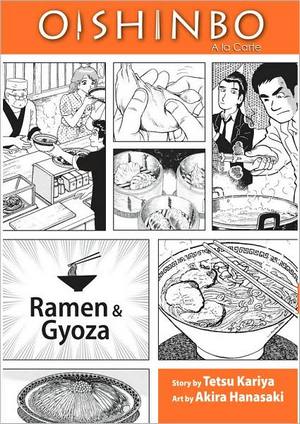- Comics
- Comics Reviews
- Manga
- Comics Reviews
- European Comics
- News
- Comics News
- Press Releases
- Columns
- Spotlight
- Digital Comics
- Webcomics
- Cult Favorite
- Back Issues
- Webcomics
- Movies
- Toys
- Store
- More
- About
By Leroy Douresseaux
May 18, 2009 - 12:45
 |
| Oishinbo a la Carte: Ramen & Gyoza cover image is courtesy of barnesandnoble.com. |
Rated “T” for “Teen”
In celebration of its 100th anniversary, the publishers of the newspaper, Tõzai News, have commissioned the creation of the “Ultimate Menu,” a model meal embodying the pinnacle of Japanese cuisine. Young food writer, Yamaoka Shirõ is known for being cynical and often lazy, but he also has a refined palate and an encyclopedic knowledge of food. He and partner, Kurita Yũko, get the job of writing the menu.
Yamaoka’s father is Kaibara Yũzan, a prominent artist with an uncanny sense of taste. Kaibara, however, is also known for his ferocious temper, as much as he is known for his voluminous knowledge of the art, preparation, presentation, and spirit of Japanese cuisine. Kaibara and his son Yamaoka are now bitter enemies, and Tõzai News’ rival, Teito Times, has commissioned Kaibara to head the “Supreme Menu,” a project to rival the “Ultimate Menu.”
In Oishinbo a la Carte: Ramen & Gyōza (Vol. 3), Kaibara and Yamaoka engage in a series of father/son duels. First, Yamaoka gets pulled into a feud between twin brothers and rival ramen shop owners in “The Soul of Ramen.” Then, father and son see who can make Hiyashi Chūka, a Chinese soup-and-noodle dish adopted by the Japanese, into something more than just a culinary joke. In “Battle! Village Revival” father and son assist rival, rural villages in creating a menu that will attract tourists, or they’ll only make the rivalry worst. The next fight is a battle for the best gyōza when father and son once again find themselves each taking sides between opposing gyōza restaurants, as they try to make this Chinese dish more than just Japanese fast food.
THE LOWDOWN: In Japan, the Oishinbo manga series is considered culturally significant because the journey it takes through the world of Japanese cooking and food culture, as it also examines so many aspects of the wider Japanese culture. For instance, one of the stories in Ramen & Gyōza explains the complex relationship between Japan and China by examining what name each nation uses for the other and why.
Reading Oishinbo can also make the reader hungry, but that hunger won’t be for just any old food. Oishinbo isn’t always about fancy cuisine or gourmet meals. It’s also about good food made from fresh ingredients, especially organically produced ingredients. Oishinbo can be seen as a manifesto against the industrial production of food and food products, especially the use of meat in which the animals live in wretched conditions, are given poor quality food, and then are processed for consumption at too young an age. That writer Tetsu Kariya and artist Akira Hanasaki can make such a fine comic book out of food culture still amazes me, even after reading three volumes.
POSSIBLE AUDIENCE: Foodies, especially those interested in Japanese food, will find Oishinbo a must-read, as well as readers looking for exceptional comic book series.
A